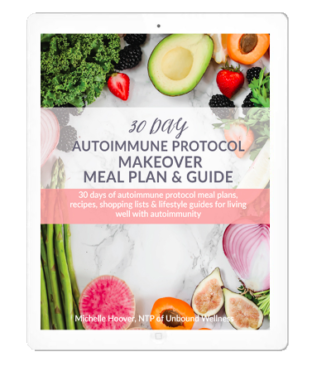My 5 Biggest Gut Healing Mistakes
I never really thought that stomach problems were my main health issue when I first started showing autoimmune disease symptoms. It seems like everyone has digestive issues, so my stomach aches and pains felt normal. I thought my real issues were low energy, and unbalanced hormones. I was incredibly tired, anxious, sweaty, and irritable until I was finally diagnosed with Hashimoto’s disease. This gave some light to my symptoms, but it never addressed the root cause. After years of battling this roller coaster of symptoms and flares, I finally learned the autoimmune gut connection and became determined to restore my health by healing my gut. However, it wasn’t that easy.
First, what is the autoimmune gut connection and how do our guts get damaged?
Digestive issues that are seemingly common like reflux, bloating, and constipation, are canary’s in the coal mine for damage to our guts. These issues caused by nutritional deficiencies, poor diet, and poor eating habits can harshly damage out gut lining. 70-80% of our immune system is located in our gut, and our intestinal lining is no thicker than our eyelash. When we’re not digesting our food, our intestinal lining becomes damaged allowing proteins, fats, and other molecules that have no business leaking into our body begin doing just that. Our already damaged immune system begins becoming more confused. This can eventually result in autoimmunity.
Needless to say from the title, I’ve been around the gut health block a few too many times. I’ve walked out of doctors offices at least three times hundreds of dollars lighter, and toting an array of powders, supplements, and brief instruction on how to heal my gut. Though some of these doctors were far better than others in helping me along my journey, I failed after taking it all home.
The typical gut healing protocol involves four “R’s”:
- Remove
- Repair
- Reinoculate
- Reintroduce
Remove the
ors, repair the gut, add in good gut bacteria, and reintroduce the foods. Seems fairly simple, right? What I missed, and so many others do for years is that the process of rebuilding your gut heath is more than just a four bullet point solution. It’s about more than the bone broth that we see on shelves now, and it’s about more than a quick fix diet. There is much more in between the lines.
After trying and failing entirely too many times, I can confidently say that my journey still isn’t over. I’m still susceptible to these issues after years of suffering, so I have to always be mindful. Both during my own gut health journey, and during my education in becoming a Nutritional Therapy Practitioner, I learned what I was really doing wrong in my attempts to heal my gut. Here’s what i want you to know…

1.I needed more than 30 days, and you likely will too.
When I was taking my Nutritional Therapy finals in Austin, I stayed in a hotel room that had an entire channel devoted to diet and exercise infomercials. As you can guess, they all came with dramatic results, and promises of those results coming quickly. We’re a world of quick fixes, and even a the autoimmune protocol which is a more intensive therapeutic diet is set with the expectations of only needing 30 days before you can start reintroducing foods. I sincerely disagree.
Though it may indeed take some people less time than others, there is no one standardized time that the gut and the body are systemically healed. Everyones journey is incredibly different, and what worked for me to help heal my digestion and manage my Hashimoto’s will likely not be exactly what works for you.
Think of it this way… if your gut is damaged enough to have inflicted autoimmune disease or serious digestive issues, it’s likely been damaged for quite sometime. It’s been said that it can take up to few months to heal for every year of being sick. Thus, we can’t expect to reverse the damage done over years in just 30 days.
Being optimistic and seeing a light at the end of the tunnel is totally necessary to keep your hope and sanity. However, setting your expectations to your journey lasting longer than just 4 short weeks is also necessary.
2. It’s about more than just bone broth.
Turn on any podcast, or open any blog post where they mention leaky gut, and they will likely mention bone broth in the same breath. Bone broth is an amazing, traditional food which does have the ability to help heal the gut as it’s rich in collagen and amino acids. However, one cannot heal the gut with broth alone.
I can’t say that I was every overly dependent on bone broth, but I put too much weight on it. I would see drinking a cup of broth as basically canceling out any inflammatory food I consumed. That’s just simply not the case.
Broth should be included in your gut healing protocol, for sure. However, be careful to not use it as an excuse to forgo other practices like cutting down on stress, healing your digestive process, and more. A daily cup of broth alone won’t be sufficient to restore gut health.
3. We need to heal the digestive process rather than just heal the gut lining.
This is probably the biggest misconception within the gut healing world. There’s so much stress put on glutamine, and aloe, and broth to heal the gut lining, but nothing about the digestive process.
So, what’s the difference? Healing your gut lining is clearly still important as that is indeed the main issue at hand. However, digestion is a north to south process, and we need to support the entire system and process. Just like you can’t target just your arms in the gym, your stomach lining along cannot be effectively spot treated without considering the entire system.
Digestion begins in the brain, then is continued in the mouth, stomach where hydrochloric acid is stimulated along with digestive enzymes then the gall bladder chimes in, then small intestines, large intestines, and finally the colon. With tradition “gut healing” we’re only targeting the small intestines. However, what about the brain, mouth, stomach, and gallbladder? Any dysfunction up north leads to poorly digested food reaching the small intestines. Remember that “leaky gut” is essentially causes by poorly digested food damaging the small intestines. When we don’t digest properly further up stream, our small intestines will just keep getting damaged despite our best efforts.
Picture this… you’ve gone through a 90 day protocol of hardcore gut healing. You’ve done the broth, the glutamine, and you’ve cut out all of the “no” foods like dairy and gluten. So, we heal the small intestine. Great. But, let’s say you have a sluggish gallbladder. You get nauseous sometimes and feel bloating after high fat meals. This dysfunction causes poorly digested fats that then have to pass through your small intestines, and you guessed it, it damages them yet again.
This was my problem for years. I was spot treating my small intestines but never addressed my reflux, bloating, gallbladder pains, and stress while I was eating. Thus, I failed over and over and over again.
So, how do you heal your digestive process? The first step is admitting you have a problem. Cliche, yes, but you have to be honest with yourself and admit that your gas, bloating, etc. are not normal. You need help to correct it. I highly recommend working with a naturopath or nutritional therapist to help work one on one with you. This is highly individualized and cannot be given a blanket treatment.
4. Stress will make it worse.
We know, we know, stress is bad. I knew that too, but that didn’t mean that I did anything about it. I was chronically stressed around food, my diet, my health, and a myriad of other things. We can all admit to be stressed, but we do little about it. However, stress is detrimental to any healing protocol and it kept me sick longer.
First, stress impacts our digestion. Like I said, digestion begins in the brain. We need to be in a relaxed state to eat or we will not trigger our gastric juices to digest our food. Thus, leading to improperly digested food, and the cycles goes on.
Also, cortisol, our stress hormone can reduce white blood cell activity and immunity. So, while we’re doing this amazing process to restore and fix our immunity, stress will only make it worse.
Finally, stress just makes our situation worse when we perceive it to be worse. Our perception creates our reality. If we’re chronically stressed and focus on the bad things, it just makes our situation worse, and the cycle continues.
I had to stop stressing around food (which I wrote more about here) as well as start practicing more self care, and taking a more positive approach to my health. It’s all a process, and we have to learn how to do it, but it’s worth it.
5. There is no one size fits all protocol… customize your approach.
I love AIP (autoimmune protocol) and the community around it. It fits my own sensitivities so well, and following it really let me take my healing to the next level. I also love GAPS, SCD, paleo and low-fodmap templates for many. However, I believe that they’re just that… templates. No one approach will fit for everyone. I tried to fit into a box of just gluten-free living for years, yet it never really got me anywhere.
Following a protocol like SCD, GAPS, AIP, etc. as a template are all great starting points. However, there will almost always be some sort of customization. For example, pineapple may be AIP, but I have a terrible reaction to it and have for years. If I were just following what protocol lined out, I would have still been aggravating my immune system.
So, how do you customize? Listening to your body and your innate intelligence will always serve you well. I also recommend pulse testing, and journaling to help ferret out any more intolerances.
We all make mistakes… I made a lot in my first attempts at gut healing. I share this with you in hopes that you can learn from my mistakes and be that much more successful on your own healing journey.







Thank you for sharing so honestly! I look forward to reading your blog and e-book more so I can start healing my gut too! 🙂
Thank you, Sam!! I hope that it’s all super helpful to you and your journey <3 praying for your continued healing!
Pingback: Gut Healing Guide - Unbound Wellness
Pingback: How To Maintain Gut Health At Every Stage of Healing - Unbound Wellness
Thank you for the great advice, I am looking forward to my journey with the AIP. I also have gallbladder pains, that have become less frequent over the 3 years since they began. Interesting that pineapple gives you a negative reaction, because I get horrible pain when I eat it (also get pain with quinoa, kale).
Wondering if you have healed your gallbladder in any way, I would love to know!
Hey, Autumn! Glad this post was helpful 🙂
For my gallbladder, one of the best things that I’ve done is just focused on digestion in general, as well as eating quality fats. Our gallbladder needs health bile movie through it to function properly, so eating balanced, quality fats is crucial. Animal fats, quality olive oil, avocado, etc. and making sure that they’re paired with carbs/protein. I also really like castor oil packs over my liver/gallbladder area and recommend a great supplement to my clients 🙂